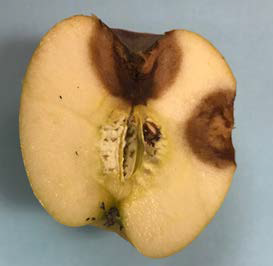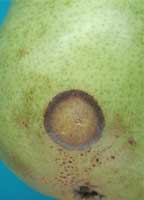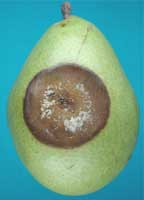ID Gallery: Bull’s Eye Rot
Bull’s eye rot (BER) is a continuous threat to apple and pear storability in the PNW and in many other growing regions. Recent surveys from Washington State showed that BER accounted for 8 to 10% of overall decayed fruit and 40% of the surveyed orchards had BER at frequencies ranging between 1% and 75% (Amiri and Ali 2016). Some cultivars, such as Golden Delicious and Pinata are highly susceptible to Neofabraea spp., but other cultivars such as Fuji, Cripps Pink, and Granny Smith can also be at risk, especially when rainy conditions occur before harvest.
For more information about Bull’s eye rot and how to manage the disease see our page Postharvest Diseases: Bull’s Eye Rot.
Bull’s Eye Rot in Apple
Bull’s eye rot on a Golden Delicious fruit. The lesion is flat to slightly sunken, brown to dark brown with lighter brown to tan center. Photo: CL Xiao, USDA-ARS.
Bull’s eye rot originating from an infection in the stem bowl of this Golden Delicious apple. Photo: CL Xiao, USDA-ARS.
Bull’s eye rot originating from the stem bowl of this Gala apple. Photo: A. Amiri, WSU Plant Pathology.
Bull’s eye rot originating from a lenticel infection on Gala. Compare to next image. Photo: A. Amiri, WSU Plant Pathology.
A more advanced Bull’s eye rot infection originating from a side wound. Acervuli beginning to appear. Photo: A. Amiri, WSU Plant Pathology.
Advanced stage of Bull’s eye rot on Fuji apple. White mycelium and cream-colored spore masses clearly visible. Photo: A. Amiri, WSU Plant Pathology.
Bull’s Eye Rot of Pear
Advanced stage of Bull’s eye rot on a d’Anjou pear fruit; white mycelium and cream-colored spore masses present at the center. Photo: CL Xiao, USDA-ARS.

















